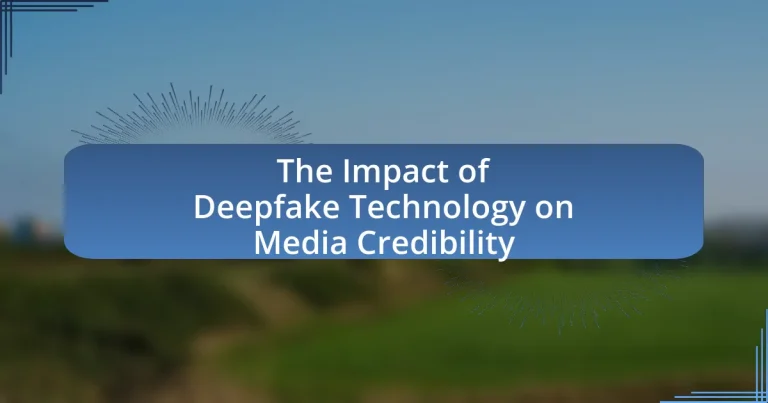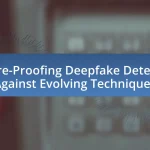Deepfake technology poses a significant threat to media credibility by enabling the creation of highly realistic but fabricated audio and video content. This manipulation complicates the audience’s ability to distinguish between authentic and altered media, leading to widespread misinformation and a decline in trust towards legitimate news sources. The article explores the functioning of deepfake technology, its technical components, and the implications for journalism and public perception. It also discusses the importance of media credibility, the role of trust in media consumption, and the measures that can be taken to combat the challenges posed by deepfakes, including detection tools, media literacy initiatives, and regulatory frameworks.

What is the Impact of Deepfake Technology on Media Credibility?
Deepfake technology significantly undermines media credibility by enabling the creation of hyper-realistic but fabricated audio and video content. This manipulation can lead to misinformation, as audiences may struggle to distinguish between authentic and altered media. A study by the Massachusetts Institute of Technology found that deepfakes can reduce trust in media sources, with 85% of participants expressing concern about the potential for deepfakes to mislead the public. Furthermore, the rise of deepfake technology has prompted calls for stricter regulations and the development of detection tools to combat its misuse, highlighting the urgent need for media literacy among consumers.
How does deepfake technology function in media?
Deepfake technology functions in media by utilizing artificial intelligence algorithms, particularly deep learning techniques, to create realistic but fabricated audio and visual content. This process involves training neural networks on large datasets of images and videos to learn the features of a person’s face and voice, enabling the generation of new content that mimics these characteristics. For instance, a common method is the use of Generative Adversarial Networks (GANs), where two neural networks compete against each other to improve the quality of the generated media. Research has shown that deepfake technology can produce highly convincing results, making it challenging for viewers to discern between authentic and manipulated content, which raises significant concerns regarding media credibility and misinformation.
What are the technical components of deepfake technology?
The technical components of deepfake technology primarily include generative adversarial networks (GANs), autoencoders, and large datasets for training. GANs consist of two neural networks, a generator and a discriminator, that work against each other to create realistic synthetic media. Autoencoders are used to encode and decode images, allowing for the manipulation of facial features in videos. Large datasets, often comprising thousands of images and videos of the target individual, are essential for training these models to ensure high fidelity in the generated content. These components collectively enable the creation of convincing deepfake media, which can significantly impact media credibility by blurring the lines between real and fabricated content.
How do these components contribute to media manipulation?
Deepfake technology contributes to media manipulation by enabling the creation of hyper-realistic but fabricated audio and visual content that can mislead audiences. This technology allows individuals or organizations to produce videos that convincingly depict people saying or doing things they never actually did, thereby distorting reality. For instance, a study published in the journal “Nature” by Chesney and Citron in 2019 highlights how deepfakes can undermine trust in media by making it increasingly difficult for viewers to discern authentic content from manipulated material. As a result, the proliferation of deepfakes can erode public confidence in legitimate news sources and foster misinformation.
Why is media credibility important in today’s society?
Media credibility is crucial in today’s society because it directly influences public trust and informed decision-making. In an era where misinformation and deepfake technology are prevalent, credible media sources serve as a foundation for accurate information dissemination. According to a 2020 study by the Pew Research Center, 53% of Americans believe that misinformation has a significant impact on their understanding of current events, highlighting the necessity for reliable media to combat false narratives. Furthermore, credible media fosters democratic engagement by ensuring that citizens have access to truthful information, which is essential for participating in civic life and making informed choices.
What role does trust play in media consumption?
Trust is fundamental in media consumption as it determines the audience’s willingness to accept and engage with the information presented. When consumers trust a media source, they are more likely to believe its content, which directly influences their perceptions and behaviors. Research indicates that 66% of consumers consider trustworthiness a key factor in their media choices, highlighting its critical role in shaping public opinion and information dissemination. In the context of deepfake technology, the erosion of trust can lead to skepticism towards all media, as audiences may struggle to discern authentic content from manipulated material, further complicating their media consumption habits.
How can deepfake technology undermine this trust?
Deepfake technology can undermine trust by creating highly realistic but fabricated audio and visual content that misrepresents individuals and events. This manipulation can lead to misinformation, as viewers may struggle to distinguish between genuine and altered media, eroding confidence in authentic sources. Research from the Massachusetts Institute of Technology indicates that deepfakes can significantly influence public perception, with studies showing that 85% of participants could not identify manipulated videos. This inability to discern truth from deception fosters skepticism towards all media, ultimately damaging the credibility of legitimate journalism and information dissemination.
What are the potential consequences of deepfake technology on media credibility?
Deepfake technology can significantly undermine media credibility by creating realistic but fabricated audio and video content that misleads audiences. This manipulation can lead to the erosion of trust in legitimate news sources, as viewers may struggle to distinguish between authentic and altered media. A study by the University of California, Berkeley, found that 85% of participants could not accurately identify deepfake videos, highlighting the potential for widespread misinformation. As deepfakes become more sophisticated, the risk of damaging reputations and influencing public opinion through false narratives increases, further complicating the media landscape.
How can deepfakes influence public opinion and perception?
Deepfakes can significantly influence public opinion and perception by creating realistic but fabricated audio and visual content that can mislead viewers. This technology can manipulate narratives, as seen in instances where deepfakes have been used to produce false statements from public figures, thereby shaping audience beliefs and attitudes based on misinformation. For example, a study published in the journal “Nature” found that deepfake videos can alter viewers’ perceptions of political candidates, leading to decreased trust in media sources and increased polarization among audiences. Such effects highlight the potential of deepfakes to undermine media credibility and distort public discourse.
What are the implications for journalism and reporting?
The implications for journalism and reporting due to deepfake technology include a significant erosion of trust in media sources. As deepfakes become more sophisticated, they can create highly convincing but false representations of events or statements, leading to misinformation and confusion among the public. A study by the Massachusetts Institute of Technology found that misinformation spreads six times faster than factual information on social media, highlighting the potential for deepfakes to amplify this issue. Consequently, journalists must adopt more rigorous verification processes and educate audiences about the existence and risks of deepfakes to maintain credibility and ensure accurate reporting.
How can we identify deepfake content in media?
Deepfake content in media can be identified through a combination of technological analysis and human observation. Techniques such as analyzing inconsistencies in facial movements, unnatural blinking patterns, and mismatched audio-visual synchronization are effective indicators. Research by the University of California, Berkeley, highlights that deepfake detection algorithms can achieve over 90% accuracy by examining pixel-level anomalies and inconsistencies in lighting and shadows. Additionally, tools like Microsoft’s Video Authenticator and Deepware Scanner provide automated solutions to flag potential deepfakes, reinforcing the importance of technological advancements in combating misinformation.
What tools and techniques are available for detection?
Various tools and techniques are available for the detection of deepfakes, including machine learning algorithms, digital forensics, and blockchain technology. Machine learning algorithms, such as convolutional neural networks (CNNs), analyze video and audio data to identify inconsistencies that may indicate manipulation. Digital forensics techniques examine metadata and pixel-level anomalies to detect alterations in media files. Additionally, blockchain technology can provide a secure method for verifying the authenticity of media by creating immutable records of original content. These methods are supported by research indicating their effectiveness in identifying deepfake content, thereby enhancing media credibility.
How effective are these methods in maintaining media integrity?
The methods employed to combat deepfake technology are moderately effective in maintaining media integrity. Techniques such as digital forensics, AI detection algorithms, and blockchain verification have shown promise in identifying manipulated content. For instance, a study by the University of California, Berkeley, demonstrated that AI detection tools could identify deepfakes with an accuracy rate of over 90% in controlled environments. However, the rapid evolution of deepfake technology often outpaces these methods, leading to ongoing challenges in ensuring media credibility.
What measures can be taken to mitigate the impact of deepfake technology on media credibility?
To mitigate the impact of deepfake technology on media credibility, implementing robust detection tools is essential. These tools utilize advanced algorithms to identify manipulated content, thereby helping platforms and users discern authentic media from deepfakes. For instance, research by the University of California, Berkeley, demonstrated that machine learning models can achieve over 90% accuracy in detecting deepfakes, highlighting the effectiveness of such technologies. Additionally, promoting media literacy among the public can empower individuals to critically evaluate the authenticity of the content they consume, reducing the likelihood of misinformation spread.
How can media organizations adapt to the challenges posed by deepfakes?
Media organizations can adapt to the challenges posed by deepfakes by implementing advanced detection technologies and enhancing media literacy among their audiences. Advanced detection technologies, such as AI-based algorithms, can analyze video and audio content for inconsistencies that indicate manipulation, thereby helping to identify deepfakes before they are disseminated. For instance, a study by the University of California, Berkeley, demonstrated that machine learning models could achieve over 90% accuracy in detecting deepfakes, showcasing the effectiveness of these tools.
Additionally, media organizations can invest in educational initiatives that inform the public about deepfakes and their potential to mislead. By promoting critical thinking and media literacy, organizations can empower audiences to scrutinize content more effectively. Research from the Pew Research Center indicates that individuals who are educated about misinformation are more likely to question the authenticity of suspicious media, further mitigating the impact of deepfakes on public perception and trust.
What role do regulations and policies play in addressing deepfake issues?
Regulations and policies play a crucial role in addressing deepfake issues by establishing legal frameworks that deter the creation and distribution of harmful deepfake content. These regulations can include laws that classify deepfakes as a form of fraud or misinformation, thereby enabling legal action against creators and distributors of malicious deepfakes. For instance, California’s AB 730 law, enacted in 2019, specifically targets deepfakes used to harm or defraud individuals, illustrating how targeted legislation can mitigate risks associated with this technology. Furthermore, policies that promote transparency in media, such as labeling requirements for synthetic content, help to maintain media credibility by informing audiences about the nature of the content they consume.
What best practices can individuals follow to navigate media credibility in the age of deepfakes?
Individuals can navigate media credibility in the age of deepfakes by critically evaluating sources, verifying information through multiple channels, and utilizing technology designed to detect deepfakes. Critical evaluation involves assessing the credibility of the source, including its reputation and expertise in the subject matter. Verifying information through multiple channels means cross-referencing claims with reputable news outlets or fact-checking organizations, which can help identify discrepancies. Additionally, employing deepfake detection tools, such as those developed by researchers at the University of California, Berkeley, can assist in identifying manipulated media. These practices are essential as deepfake technology has advanced significantly, with a 2020 report from Deeptrace indicating a 100% increase in deepfake videos online, underscoring the need for vigilance in media consumption.


